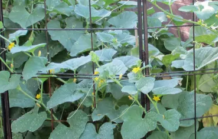Raspberries and blackberries are perennial plants with biennial canes. In other words, a single plant will last many years but an individual cane will only live for two. In a cane’s first year, it will grow but will not produce fruit. The second year, it will fruit and then die. Though these canes can be removed after they have finished fruiting, many gardeners wait until now to remove them.
Dead canes are not difficult to identify. They are a much lighter color than live canes and are dry and brittle. These canes should be removed and discarded. The remaining canes should be thinned but the type of growth determines exactly how this should be done.
Black and purple raspberries and thornless blackberries tend to grow in a clump. Remove all the canes but 5 to 7 of the largest and healthiest in each clump. Cut back the remaining canes to living tissue if there was winter damage. Thornless blackberries will also produce a few suckers that come up some distance from the clump. These should be removed or dug and transplanted to increase the planting.
Red raspberries and thorny blackberries sucker badly and will fill the row with new plants. Prune out small canes within the row so that there are strong canes 4 to 6 inches apart. Head back all the remaining canes to about 5 feet. Keep aisles free of new suckers during the summer by mowing.
We now have what is called everbearing red raspberries and everbearing thorny blackberries. These are the exception to the rule in that they will bear fruit on first-year canes. Therefore, you can cut all canes to the ground in the winter and still have fruit. Examples include Heritage red raspberry and Prime-Jim, Prime-Jan and Prime Ark 45 blackberries.
For more detail and line-drawings that illustrate pruning techniques, see our publication titled, “Raspberries and Blackberries”
at http://www.ksre.ksu.edu/




